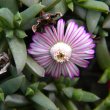| Botanical Name |
|
| Family |
Aizoaceae - The fig-marigold family or ice plant family |
| Pronunciation |
ROOS-kee-uh lin-ee-oh-LAY-ta |
| Common Name(s) |
|
| Plant Group |
- Succulent A plant having fleshy stems or leaves often adapted to dry conditions.
|
| Plant Size |
- Very Small
| Tree | 3m to 4m |
| Shrub | 25cm to 50cm |
| Perennial/ground cover | Up to 10cm |
| Bulb | 10cm to 20cm |
| Succulent | Up to 5cm |
|
| Position |
- Partial Shade The area is in shade for part of the day and in full sun for part of the day.
- Sun The area is in full sun for all or most of the day, all year round.
|
| General Information |
- Drought Tolerance: High The plant is well adapted to arid conditions; it can survive long periods of drought and high temperatures without extra water.
- Evergreen Plants that have leaves all year round.
- Frost: Half-hardy The plant is able to survive low temperatures and some frost but requires protection against severe frost.
- Sand tolerant Plants adapted to survive in nutrient poor, very sandy soils.
- Water Wise Plant species originating from low rainfall regions that require less water to survive and thrive than other plant species.
|
| Specific Information |
Ruschia lineolata is a dense, low-growing succulent which forms matted cushions of up to 60 cm in diameter. It is versatile and tough, growing in any well drained soil type and can be used in many areas of the garden. The root system is woody and close to the soil surface. Plants remain attractive for 3 to 4 years, after which they may become woody and need replacing.
|
| Ad Break |
|
| Flowers |
| Description |
daisy-like vygie flower with white stripes on pink 'petals'
|
| Season |
- Autumn Plants will seldom bloom for the entire season as given in the list, but should flower during a period within these parameters.
- Spring Plants will seldom bloom for the entire season as given in the list, but should flower during a period within these parameters.
|
| Colour |
|
| Growth Rate |
- Fast Specifying growth rate can be very misleading as there is considerable variation of growth rate depending on type and species of plant, available water, supplementary feeding, mulching and general care, as well as the plants suitability and adaptability to the garden environment.
|
| Plant Uses |
- Attracts bees, butterflies or other insects This plant attracts insects which can be food for birds or other creatures in your garden.
- Border A strip of ground, at the edge of a driveway or path in which ornamental plants or shrubs are planted.
- Container Trees, shrubs and ornamental species that can adapt to growing in a restricted environment.
- Edging A low growing plant that provides softness or definition to the edges of a bed or walkway.
- Filler Either a fast growing tree or shrub used temporarily to fill in an area while the permanent plants grow to a desired size, or a plant used to fill gaps in borders or beds.
- Ground Cover Low-lying plants that spread fast, require minimal maintenance, and cover large expanses or bare areas between bulbs or shrubs. They provide protection from erosion and drought and improve the visual appearance of the garden.
- Rock Garden An area constructed of larger rocks, arranged naturally, to emphasise the use of stones as a main element. Generally plants used do not need a lot of care.
- Stabilize Banks Plant is used to prevent soil erosion because their roots will form a mat that stabilizes the soil and keeps it from washing away in heavy rains.
- Suitable for coastal gardens Plants adapted to dry, sandy soil, forceful wind, limited rainfall and intense sunlight.
|
| Distribution and Habitat |
in the Western Cape Province, south of the Langeberg, Robertson and Barrydale districts, in the Renosterveld and succulent Karoo, on shale ridges of dry stream beds,
|
| Planting Suggestions |
Ruschia lineolata is easily propogated from cuttings. Place healthy cuttings taken before or after flowering, in river sand and water daily. Keep cuttings in a sheltered but bright position and plant out once well rooted - this should be within a month at most. Organic fertiliserrs can occasionally be applied to increase health and vigour. Full sun is required for spectacular flowering.
|
| Medicinal Uses |
|
| Ad Break |
|






Discuss this plant
Share knowledge, ask a question or give an experience.